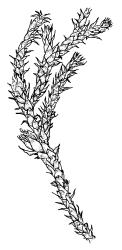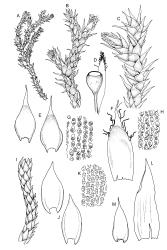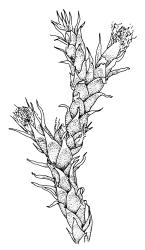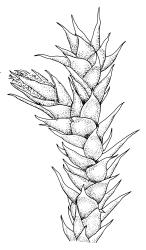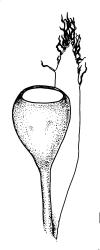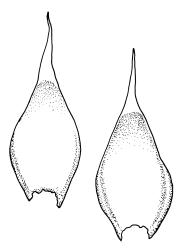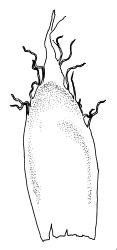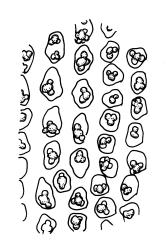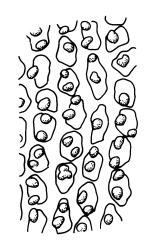- ≡ Anictangium ciliatum Hedw., Sp. Musc. Frond. 40 (1801)
- = Pilotrichum microcyatheum Müll.Hal., Bot. Zeitung (Berlin) 9: 564 (1851)
- ≡ Hedwigia microcyathea (Müll.Hal.) Paris, Index. Bryol. 554 (1896)
- = Hedwigia albicans Lindb., Öfvers. Kongl. Vetensk.-Akad. Förh. 21: 421 (1864) nom. illeg.
Plants, protonema, stems, and rhizoids as per genus. Leaves erect-spreading, widely spreading, or weakly secund when dry, spreading when moist, oblong-ovate, 2.0–2.2(–2.4) × 0.8–1.2 mm, otherwise as per genus; upper laminal cells irregularly subquadrate to short-rectangular, with very incrassate and sinuose walls, mostly (10–)12–15 × c. 6 µm, mostly with 1–2 conspicuous, peltate or stellate (or rarely simple) papillae on each surface (more prominent on adaxial surface), becoming longer (to at least 36 µm) and with more papillae in lower third of leaf; papillae of adaxial surface often appearing anastomosed under the light microscope, strongly branched and with the branches often unequal; cells of hair-point strongly differentiated, linear-fusiform, appearing white, with numerous non-stellate papillae and thick and undulate walls that obscure the lumina, the terminal cell less papillose than adjacent cells or smooth, either acute or truncate/pluripapillose at tip; central cells of leaf base gold-brown, more or less linear, to 70 µm or greater, non-papillose, strongly porose, forming a large and conspicuous group; marginal cells at base much shorter than interior cells, subquadrate in c. 15–20 rows and gradually merging with the upper laminal cells; alar cells not differentiated.
Autoicous. Perichaetia terminal on short branches, the inner leaves c. 3.0 mm, with numerous long, hyaline, and contorted marginal cilia. Perigonia 0.8–1.4 mm, scattered and usually numerous on stems, with entire leaves. Setae c. 0.4–1.5 mm; capsules immersed, c. 1 mm × 0.8 mm; exothecial cells as per genus; stomata not seen; annulus lacking; operculum as per genus. Calyptra mitrate, c. 1 mm, falling early. Spores reniform, mostly 27–30 µm, coarsely lirate-murate, often with a proximal trilete scar.
Scott & Stone 1976, pl. 67; Crum & Anderson 1981, fig. 354; Hedenäs 1994, fig. 5 (as H. ciliata var. ciliata); Meagher & Fuhrer 2003, p. 61; Seppelt et al. 2013, pl. 9.
In Hedwigia ciliata the leaf margins are plane or weakly reflexed near the leaf base when viewed under a hand-lens; this contrasts with the strongly recurved margins in Hedwigidium integrifolium. The presence of fusiform cells at the leaf tips (even when the hair-point is poorly developed) and the more strongly papillose laminal cells also clearly distinguish Hedwigia ciliata from Hedwigidium integrifolium.
Hedwigia ciliata could be confused with Schistidium apocarpum. The latter species has well-developed and dark red peristome teeth, a well-developed costa, narrower vegetative leaves, upper laminal cells that are smooth or weakly papillose-projecting (but not stellate-papillose), and non-ciliate perichaetial bracts.
NI: N Auckland (Auckland City), S Auckland (Rotorua vicinity, Ātiamuri, Taupō vicinity), Wellington (Blue Rock Stream); SI: Nelson, Marlborough, Canterbury, Otago, Southland.
Nearly cosmopolitan.
On either shaded or insolated dry rock (including greywacke, basalt, schist, and scoria); rarely on bark or "woody debris". Forming loose mats to at least 30 cm diam. Restricted to dry sites and not known from wetter portions of either main island. This species almost certainly is under-collected from parts of the NI where it occurs from near sea level (Auckland City) to at least 670 m. On SI occurring from near sea level (Christchurch) to at least 1220 m (St Arnaud Range, Nelson L.D.). This species is commonly associated with Breutelia affinis, Campylopus clavatus, Grimmia pulvinata, Hedwigidium integrifolium, Racomitrium crispulum s.l., Schistidium apocarpum, and Triquetrella papillata. Various lichens, especially Cladia aggregata, are also common associates.
A single variable taxon of Hedwigia is present in N.Z. Although some material, particularly collections from Canterbury, exhibit some of the morphological features that Hedenäs (1994) and Buck & Norris (1996) used to characterise H. stellata (especially widely spreading leaf apices and 1–2 papillae per upper laminal cell), the more familiar name H. ciliata is applied here to this material. When dry, the stance of the leaves in N.Z. material varies from widely spreading to erect, the number of upper laminal cell papillae (c. 100 µm below the base of the hair-point) varies from 1 to 3 or occasionally more, the morphology of individual papillae varies, and the nature of the terminal cell can be either truncate/papillose or acute, even within a single collection. This variability suggests that recognition of more than one taxon in N.Z. is inappropriate.
The name H. microcyathea (Müll.Hal.) Paris has been applied to both Tasmanian and N.Z. collections. There is no reason to question Mitten’s (1859) placement of the Tasmanian basionym, Pilotrichum microcyatheum Müll.Hal., in the synonymy of H. ciliata. Dixon (1927, p. 240) concurred with Mitten, but saw only N.Z. material, whereas the type is Tasmanian. There is one Beckett collection (NZ 347, Birdlings Flat, Canterbury L.D., CHR 632080), named by Müller as H. microcyathea, which is unquestionably referable to H. ciliata. The Beckett collection is almost certainly a duplicate of the collection cited by Dixon.



